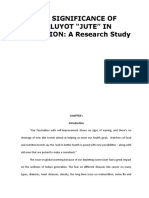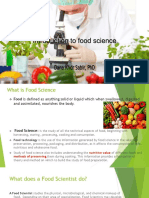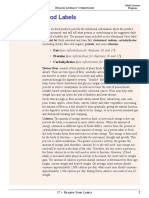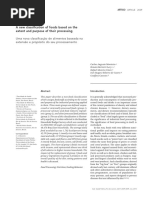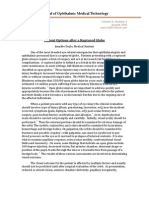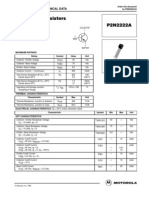Bio Molecules
Bio Molecules
Uploaded by
Iana glyxxelCopyright:
Available Formats
Bio Molecules
Bio Molecules
Uploaded by
Iana glyxxelCopyright
Available Formats
Share this document
Did you find this document useful?
Is this content inappropriate?
Copyright:
Available Formats
Bio Molecules
Bio Molecules
Uploaded by
Iana glyxxelCopyright:
Available Formats
Activity from The Science of Food Teacher’s Guide: From Ecosystems to Nutrition
and for The Mysterious Marching Vegetables
THE SCIENCE OF FOOD TEACHER’S GUIDE 1 FOOD SAFETY AND NUTRITION
© Baylor College of Medicine Environment and Health Basics
Food Safety and Nutrition
Environment and Health Basics
F
ood affects health and well-being in
two important ways. First, we require CHILDREN’S
appropriate amounts of different ENVIRONMENTA
kinds of foods to supply the energy L HEALTH
and nutrients we need for daily activities and Children are particularly
for growth and maintenance of our bodies. susceptible to contaminants
Second, food can contain contaminants that in food and in the environ-
can make us sick. ment. Because their bodies
Carbohydrates, fats and proteins are our are still growing and
main sources of energy. Our bodies also need because they eat more fruits
protein to maintain muscles and carry out and veg- etables (which may
many functions inside cells. Small amounts of contain chemical residues)
vitamins and minerals also are necessary. relative to their body
weights, children are more
Food becomes available for use by the
vulnerable to the harmful
body through the process of digestion. Diges-
effects of substances such as
tion breaks down large food molecules into lead and pesticides.
smaller ones that can be transported and However, many research-
used by the body. ers believe that a healthy
Many Americans eat too much refined diet, which provides recom-
sugar and unhealthy fats. Examples of foods mended amounts of vitamins
with little nutritional value, or with too and minerals, may help pro-
many added calories, are soft drinks, chips, tect children from potentially
greasy fried foods, candy and snack cakes. A harmful chemicals.
diet that has a lot of “junk” foods is harmful
in two ways. First, it does not provide all of the vitamins, minerals
and other substances needed for growth and health. Second, a diet AVOIDING SUGARY
with many sweets and fatty foods often delivers too many calories. DRINKS
When a person eats more calories than he or she uses up through Many soft drinks have
movement and exercise, the body stores the excess energy as fat. around 10 teaspoons of
Excess body weight can contribute to a number of serious health sugar in a
problems, such as type 2 diabetes, heart disease and stroke. 12-ounce can. These drinks,
How foods are grown and prepared also is important. Plants which have little nutritional
and animals can take in small amounts of pollutants (harmful value, contribute to the
chemicals) from water, food or soil. These nationwide epidemic of
pollutants can accumulate in the bodies of other over- weight and obesity.
living organisms that eat the smaller plants or
animals—a process known as bioaccumulation.
Food also can be spoiled by bacteria. Most bac-
teria that cause food-related illnesses are spread
because hands and food preparation areas are
not kept clean or because food is not kept at the
proper temperature.
Simple actions, such as washing hands before eating or preparing
food, help to reduce the possibility of spreading bacteria or other
harmful substances to food.
THE SCIENCE OF FOOD TEACHER’S GUIDE 1 FOOD SAFETY AND NUTRITION
© Baylor College of Medicine Environment and Health Basics
Using Food Labels
Environment and Health
B
CONCEPTS
eginning in 1994, the US Government began requiring Food labels provide impor- tant information about
manufacturers to put information about nutritional value
on food labels. This information helps people make bet- OVERVIEW
ter choices about which foods to buy and eat. Students will learn about food labels to promote th
All food labels must present the same basic information in a Students also will explore units of measurement co
standard format. This information
SCIENCE, HEALTH & MATH SKILLS
Unit Links includes, at minimum, the amount
per serving of saturated fat, choles-
Measuring
Comparing measurements
The Mysterious Marching Vegetables Story,
terol, dietary p.and
fiber, 34–35; Sciences
other boxes, p. 3Making
nutrients and 34observations
(bottom)
Explorations known to be important for health. Drawing conclusions
From the Label to the Table, p.Labels
4; Marta Fiorotto, p. 7
also provide nutrient reference TIME
values, expressed as “% Daily Preparation: 10 minutes
Values,” to help consumers see how Class: 30 minutes
a food fits into an overall daily diet.
It is important to pay attention to MATERIALS
Each group will need:
the serving sizes on any food label. Cup of white sugar
Packages also must list all ingre- Measuring cup
dients in foods. This list is given in Measuring spoon
order, by weight, beginning with the Each student will need:
Copy of student sheets
ingredient that weighs the most. This
information can be helpful when
selecting foods.
• Carbohydrates are the body’s main source of fuel. Starchy
foods like breads, spaghetti, rice, potatoes, corn and cereals are
made up mostly of carbohydrates. Sweet foods like candy, jam
and syrups also are carbohydrates. Some carbohydrates, called
fiber or roughage, are hard to digest. They help move waste
through the digestive system.
• Fats include butter, margarine, lard, shortening and cooking
oils. Meats, cheese, cream, chocolate and many desserts like
cakes and cookies usually have a lot of fat. Fats are very con-
centrated sources of energy. Some kinds of fat (particularly fats
that are solid at room temperature) have been linked to dis-
eases of the heart and circulatory system. Most Americans eat ESTIMATING
too many high-fat foods. SERVING SIZES
• Proteins are important for growth and repair of the body.
• 4 oz (1/4 lb or 114 g) of
Protein-rich foods include eggs, milk products, meat, dried
meat, poultry or fish is
beans, chicken, turkey and fish. The body also uses protein as about the same size as
fuel to provide energy for movement and growth. a deck of cards.
• Minerals are found in small amounts in foods. They are needed
• 1/2 cup of cereal or
for many of the body’s functions. For example, calcium is used
snacks is about as much as
to build bones and teeth and also is important for muscles and an adult can hold in his or
the nervous system. Iron goes into making red blood cells. her cupped hand.
• Vitamins are other chemicals found naturally in food that are
• A 12 oz can of soft
needed in very small amounts by the body. Fruits and vegeta- drink contains 1 1/2
bles are valuable sources of vitamins and minerals. cups of liquid.
All foods also contain some water.
THE SCIENCE OF FOOD TEACHER’S GUIDE 2 USING FOOD LABELS
© Baylor College of Medicine Environment and Health
SERVING SIZE is the amount onTRANS FAT is another unhealthy which the nutrition facts are based.form
If someone eats more than the serv-manufacturing of vegetable shortening ing size, he or she will receive m
of the calories and nutrients than theSODIUM is the amount of salt in a amounts listed on the label. Serv-fo
amount a typical person might eat.
CALORIES measure the amountTOTAL CARBOHYDRATE shows
HIDDEN FATS of energy a food can provide. Mostsugars, starches and different kinds of
people need somewhere around 2,000fiber. Most people eat too much sugar.
Many crackers, cookies,
to 2,500 calories a day to meet theirBrown sugar, molasses, honey and energy needs.corn syrup all are sug
candies, processed snack is important to health.
foods, fried foods and fast CALORIES FROM FAT is the amountPROTEIN is essential for building of calories that come from fats and o
foods contain trans fat in a food.functions.
TOTAL FAT gives the weight of all theVITAMINS AND MINERALS are fat in one serving. Most people sho
and saturated fat.
SATURATED FAT gives just the100% of the daily requirements of weight of unhealthful fats in one serv-vit
To learn more about foods
and USDA recommendations,
visit www.myplate.gov and
www.myfoodapedia.gov.
WATER FOR LIFE
Water makes up three-fourths of the brain and muscles.
Every cell in the body is packed with water. Water transports nutrients and wastes, helps control tem- perature, and makes many chemical reacti
Some of it is replaced with food, such as fruits and vegetables, but drinking six to eight glasses of liquid each day to maintain the
body’s water supply is recom- mended.
Source: The Science of Water Teacher’s Guide. Baylor College of Medicine.
SETUP
Have students work in groups of 2 – 4. Set up sugar and
other materials in a central location.
PROCEDURE
1. Remind students of the food guides they used at the beginning
of this unit. Ask, How can we be sure that the foods we eat
each day contain the nutrients we need?
2. Mention that packaged foods now have uniform labels that
provide information about the nutritional value of foods.
Distribute copies of the student page.
3. Have students read the label depicted on the student page out
loud in their groups. Follow by helping them understand the
concepts outlined in the box above.
4. Ask students, What units of measure are mentioned on the
label? (cups and grams). Mention that they will be investigat-
ing these measures using sugar.
5. Have students, in their groups, follow the instructions on the
Sugar Measures Up page. They will explore how much sugar is
contained in a typical soft drink.
6. Afterwards, ask, Were you surprised about the amount of
sugar in one soft drink? How many soft drinks would you
need to meet your daily total carbohydrate requirement? Do
you think that that would be a good way to fuel your body?
USING FOOD LABELS 3 THE SCIENCE OF FOOD TEACHER’S GUIDE
Environment and Health © Baylor College of Medicine
From the Label to the Table!
Pay close
attention to
serving sizes.
Products labeled
“light” or “lite”
Look for must have 1/3 fewer
foods with calories or 1/2 the fat
lower levels of the foods to
of saturated which they
fats. are compared.
“Light” also
can mean that
salt has been
This tells
reduced
you how much
by 1/2.
salt is in food.
Calcium is
important
Look for
for bones
products that
and teeth.
have more fiber
and less sugar.
Use this
section as
a guide for
daily plannng. Vitamins and
minerals help
your body
function properly.
The
amount of
calories a person
needs each day
depends
on many factors,
including exercise.
THE SCIENCE OF FOOD TEACHER’S GUIDE 4 USING FOOD LABELS
© Baylor College of Medicine Environment and Health
THE SCIENCE OF FOOD TEACHER’S GUIDE 4 USING FOOD LABELS
© Baylor College of Medicine Environment and Health
Sugar Measures Up
You will need a measuring cup,
a teaspoon, and sugar.
1. Think about an ordinary can of PREDICTION
your favorite soft drink. The can
holds 12 ounces of liquid. How
many
teaspoons of dissolved sugar do you
think is in one can of soft drink?
2. On the measuring cup to the right,
draw a line to show the amount of
sugar you predict is in one can of
soft drink.
3. Now, use the following information
to answer the question below.
An average soft drink contains
about 40 grams of sugar.
One teaspoon of sugar weighs
4 grams.
How many teaspoons of sugar are
in a can of soft drink?
4. Put that many teaspoons of
sugar into the measuring cup.
5. Look at the amount of sugar actually
in your measuring cup. On the
measuring cup to the right, draw a
line showing the actual amount of
sugar in a can of your favorite
soft drink.
THE SCIENCE OF FOOD TEACHER’S GUIDE 6 USING FOOD LABELS
© Baylor College of Medicine Environment and Health
ACTUAL
THE SCIENCE OF FOOD TEACHER’S GUIDE 6 USING FOOD LABELS
© Baylor College of Medicine Environment and Health
You might also like
- Intuitive Tarot Guide BookDocument28 pagesIntuitive Tarot Guide BookMystic100% (4)
- Contemporary Nutrition 9th Edition by Wardlaw and Smith ISBN 125933208X Solution ManualDocument10 pagesContemporary Nutrition 9th Edition by Wardlaw and Smith ISBN 125933208X Solution Manualcharles100% (33)
- Metainfo 2Document58 pagesMetainfo 2Bogdan GabrielNo ratings yet
- Food Groups - A Guide in Menu PlanningDocument6 pagesFood Groups - A Guide in Menu PlanningkicsirekaNo ratings yet
- Ideology of NutritionismDocument10 pagesIdeology of NutritionismDolle CristianNo ratings yet
- Rustomjee CrownDocument19 pagesRustomjee CrownParthasarathy SrinivasanNo ratings yet
- Valve Procurement SpecsDocument39 pagesValve Procurement Specsjoseph.maquez24100% (2)
- PEDIA-3NutritionalDisorders TransDocument6 pagesPEDIA-3NutritionalDisorders TransmalvincayabyabNo ratings yet
- Health Teaching SPEDDocument10 pagesHealth Teaching SPEDSheena Mae FloresNo ratings yet
- Foods and NutDocument25 pagesFoods and NutekerossyNo ratings yet
- The Significance of SaluyotDocument33 pagesThe Significance of SaluyotRo-Anne Nuguit - Obligar0% (1)
- 8 Nilima Y. Bhoge IJTAS 7 (1) 2015Document5 pages8 Nilima Y. Bhoge IJTAS 7 (1) 2015abdullah khalidNo ratings yet
- "To Eat Is A Necessity, But To Eat Intelligently Is An Art." La RochefoucauldDocument9 pages"To Eat Is A Necessity, But To Eat Intelligently Is An Art." La RochefoucauldChristine Joy MolinaNo ratings yet
- Lehe 102Document17 pagesLehe 102raymondabaduNo ratings yet
- The Significance of SaluyotDocument33 pagesThe Significance of SaluyotJonne Pearl Alas67% (6)
- Nutrition & Household MGTDocument6 pagesNutrition & Household MGTKasalika jrNo ratings yet
- Role of Food and Nutrition in Daily LifeDocument1 pageRole of Food and Nutrition in Daily Lifeheldergourgel30No ratings yet
- Baking For Special Diets: After Reading This Chapter, You Should Be Able ToDocument25 pagesBaking For Special Diets: After Reading This Chapter, You Should Be Able ToMaryyKenny RamosNo ratings yet
- UC 14 Human NutritionDocument41 pagesUC 14 Human NutritionTesfayeNo ratings yet
- NCM 105 Nutrition and Diet Therapy:: Ferkiya A. Abduwa, R.NDocument29 pagesNCM 105 Nutrition and Diet Therapy:: Ferkiya A. Abduwa, R.NLouie Pangilinan LanajaNo ratings yet
- Lesson 02 Introduction To Basic Concept in Nutrition and Diet TherapyDocument4 pagesLesson 02 Introduction To Basic Concept in Nutrition and Diet TherapyMickey MouseNo ratings yet
- CULN (Reviewer)Document3 pagesCULN (Reviewer)RACHELLE MAE LLAGASNo ratings yet
- Assesment1 Task2Document25 pagesAssesment1 Task2anna.koscielska95No ratings yet
- Module 1 NutritionLecDocument5 pagesModule 1 NutritionLecbekbekk cabahugNo ratings yet
- HNS-REVIEWER-WEEK-1-8Document4 pagesHNS-REVIEWER-WEEK-1-8vdios1128No ratings yet
- FST01 Unit 21 To 30Document151 pagesFST01 Unit 21 To 30sumit prajapatiNo ratings yet
- Unit 21 Food and Nutrition: StructureDocument16 pagesUnit 21 Food and Nutrition: StructureanonymousNo ratings yet
- 1 Script200302090903033030Document9 pages1 Script200302090903033030gever29816No ratings yet
- Lesson 1 - Nutrition Nutrients Health 2024 - StreamDocument35 pagesLesson 1 - Nutrition Nutrients Health 2024 - StreamMeaza Kidusan ElhamNo ratings yet
- The Healthy Bones Plant-Based Nutrition Plan and Cookbook: IntroductionDocument8 pagesThe Healthy Bones Plant-Based Nutrition Plan and Cookbook: IntroductionChelsea Green PublishingNo ratings yet
- Talk Plan About Healthy EatingDocument12 pagesTalk Plan About Healthy EatingScribdTranslationsNo ratings yet
- Drug Education 2Document11 pagesDrug Education 2Erick Tesoro AgarcioNo ratings yet
- ENGLESH Lorcio English Field Work PRFDocument9 pagesENGLESH Lorcio English Field Work PRFyasser zandamelaNo ratings yet
- FSN 101 Lecture NotesDocument140 pagesFSN 101 Lecture NotesMothika SNo ratings yet
- Nutrition-Principles FinalDocument9 pagesNutrition-Principles FinalRikkard AmbroseNo ratings yet
- Healthy Food ProjectDocument10 pagesHealthy Food ProjectScribdTranslationsNo ratings yet
- (ABHN) Applying Basics of Human Nutrition PracticesDocument144 pages(ABHN) Applying Basics of Human Nutrition Practicesmypc848573100% (1)
- Food Science & NutritionDocument4 pagesFood Science & NutritionGURDIAL SINGH SIDHUNo ratings yet
- Chapter 1 - Food in Our BodyDocument10 pagesChapter 1 - Food in Our BodyabiramiNo ratings yet
- Food in Relation To DiseasesDocument40 pagesFood in Relation To DiseasesSolomonNo ratings yet
- Module 3 Health 7Document8 pagesModule 3 Health 7Cryzel MuniNo ratings yet
- SCIENCE Summative Assessment Task - VedikaDocument6 pagesSCIENCE Summative Assessment Task - VedikaVedika MishraNo ratings yet
- New Solved Questions For Applied Nutrition Seqs 2021Document64 pagesNew Solved Questions For Applied Nutrition Seqs 2021Amina GulNo ratings yet
- Chapter 1 PDFDocument30 pagesChapter 1 PDFZhwan Raouf AwlNo ratings yet
- Oct Q1 PE 1 - W4Document5 pagesOct Q1 PE 1 - W4Christy BetitaNo ratings yet
- Separata Nutriciòn Tècnico 2020-1Document58 pagesSeparata Nutriciòn Tècnico 2020-1karlaNo ratings yet
- Dietary Diversity Fact SheetDocument2 pagesDietary Diversity Fact Sheetcaptaincupcakes95No ratings yet
- Isabela State University City of Ilagan CampusDocument27 pagesIsabela State University City of Ilagan CampusCharlz ZipaganNo ratings yet
- Module 3 PATHFit 1Document16 pagesModule 3 PATHFit 1gabriel.cayabyab26No ratings yet
- Learning Unit 1-Nutrition FP30EHDocument64 pagesLearning Unit 1-Nutrition FP30EHYekhetheloNo ratings yet
- RGSMC Learning Packet Week 1 P.E 9 UpdatedDocument4 pagesRGSMC Learning Packet Week 1 P.E 9 UpdatedAizel Nova Fermilan ArañezNo ratings yet
- Concept of Community NutritionDocument4 pagesConcept of Community NutritionNrs Sani Sule MashiNo ratings yet
- Unit Ii: Nutrition, Food Science and TechnologyDocument17 pagesUnit Ii: Nutrition, Food Science and TechnologyArshdeep SinghNo ratings yet
- Local Media5700755227755762789Document9 pagesLocal Media5700755227755762789Andrew LaguraNo ratings yet
- Food Labels ExerciseDocument20 pagesFood Labels ExerciseAnonymous h2EnKyDbNo ratings yet
- 4 C 36Document11 pages4 C 36Dita AnggraeniNo ratings yet
- PATHFIT UNIT 4 - Nutrition and NutrientsDocument2 pagesPATHFIT UNIT 4 - Nutrition and NutrientsRhea Mae PerezNo ratings yet
- Foods LET ReviewDocument17 pagesFoods LET ReviewAppolos NuezNo ratings yet
- W INGLES - Pt.enDocument13 pagesW INGLES - Pt.enGOSMENo ratings yet
- MODULE 1 - Why Is Nutrition ImportantDocument6 pagesMODULE 1 - Why Is Nutrition ImportantDonna MarieNo ratings yet
- Nutrition and Diet Theraphy LabDocument6 pagesNutrition and Diet Theraphy LabCrystal MiranaNo ratings yet
- Final CHPTR 1 ResirtsDocument14 pagesFinal CHPTR 1 ResirtstswtseinstNo ratings yet
- Diagrama Especial NeveraDocument1 pageDiagrama Especial NeveraDimitri Cuellar HaztziyannisNo ratings yet
- Stat-231 Practical ManualDocument45 pagesStat-231 Practical Manualkartikrajput893No ratings yet
- CatDocument15 pagesCattejasg82No ratings yet
- Astm D4719-20Document2 pagesAstm D4719-20Marina FerreiraNo ratings yet
- Fosroc Conbextra Cable Grout: Constructive SolutionsDocument4 pagesFosroc Conbextra Cable Grout: Constructive SolutionsVincent JavateNo ratings yet
- Tears of The Tree - The Story of Rubber - LoadmanDocument367 pagesTears of The Tree - The Story of Rubber - LoadmanUriel Soto VarelaNo ratings yet
- Kamitani 2013Document8 pagesKamitani 2013Maria MaríaNo ratings yet
- Isolcell 2022 en WEBDocument40 pagesIsolcell 2022 en WEBwendyNo ratings yet
- Ruptur BulbiDocument5 pagesRuptur BulbiseptrealtiNo ratings yet
- 154 Bettis Cba-Series CatalogDocument16 pages154 Bettis Cba-Series CatalogsebastianNo ratings yet
- Carnall 3Document20 pagesCarnall 3Efer HuertaNo ratings yet
- List of Project Work - Grade 12 PCMB (1)Document12 pagesList of Project Work - Grade 12 PCMB (1)harshitprasad09No ratings yet
- MRF Organisation Study ReportDocument84 pagesMRF Organisation Study ReportTony Jacob84% (37)
- Modulus ElasticityDocument8 pagesModulus ElasticityLhizaNo ratings yet
- Universal Grammar: Rizal Technological University Maybunga, Pasig City College of EducationDocument4 pagesUniversal Grammar: Rizal Technological University Maybunga, Pasig City College of EducationManilyn PericoNo ratings yet
- Topic: Company Presentation (Bisleri) : by Tanishka Sharma Preeti Inchulkar Prakhar SharmaDocument15 pagesTopic: Company Presentation (Bisleri) : by Tanishka Sharma Preeti Inchulkar Prakhar SharmaNitin gNo ratings yet
- Service Instruction: LycomingDocument6 pagesService Instruction: LycomingGANo ratings yet
- Desalting Process in GOSPDocument10 pagesDesalting Process in GOSPmaethaam hadeyNo ratings yet
- UG Annual 2021Document17 pagesUG Annual 2021owa senseiNo ratings yet
- Excel Programs-Softwares-Books-Novels: Computer TricksDocument18 pagesExcel Programs-Softwares-Books-Novels: Computer Tricksraj151857No ratings yet
- Analytical Chemistry - Multiple Choice - UkraineDocument23 pagesAnalytical Chemistry - Multiple Choice - UkrainethucinorNo ratings yet
- Case Study Project ManagementDocument2 pagesCase Study Project ManagementHoa Quỳnh0% (1)
- ASTMB936Document4 pagesASTMB936eng.usmanali2012No ratings yet
- Tank Container Sealing GuideDocument12 pagesTank Container Sealing GuideFher GallardoNo ratings yet
- Prelude: From Cello Suite No. 1 in G MajorDocument7 pagesPrelude: From Cello Suite No. 1 in G Major林書弘Henry LinNo ratings yet
- DataSheet 2n222Document6 pagesDataSheet 2n222evhyajahNo ratings yet














